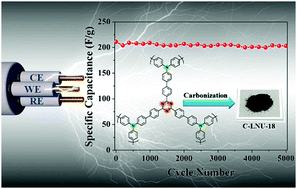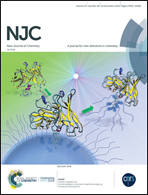A carbonized porous aromatic framework to achieve customized nitrogen atoms for enhanced supercapacitor performance†
Abstract
In this study, a porous aromatic framework (PAF) material (LNU-18) with two kinds of nitrogen atoms (Ntriazine and Namine) was prepared via a Suzuki coupling reaction. After carbonization at 700, 800, and 900 °C, there is no obvious change in the morphology of the samples compared with their precursor accompanied by an enlargement in the surface area. Evaluated in an alkali environment (6 M KOH), LNU-18-800 as the electrode material reached a maximum specific capacitance of 269 F g−1 at a current density of 0.5 A g−1. To reveal their excellent electrochemical properties, PAF-48, with a similar theoretical structure to LNU-18 but with the whole carbon skeleton being carbonized, shows a capacitance of 54 F g−1, which is ca. four times lower than that of LNU-18-800. This is because the strong covalent bonds in the porous aromatic framework will maintain the chemical structure of N atoms, and the customized nitrogen atoms (Ntriazine and Namine) in porous carbons enhance the capability to function as high-performance supercapacitors. This study demonstrates that porous aromatic frameworks as precursors will generate the special N atoms for further investigation of porous carbon electrodes.



 Please wait while we load your content...
Please wait while we load your content...